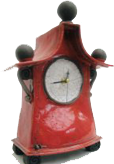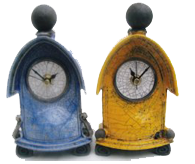 |
|
   |
Options
Raku Pottery
The firing of pottery in the Raku style was first recorded in the sixteenth Century in Japan. It's origins derive from the production of wares for the tea ceremony which was an important part of Japanese life.
The Raku pieces produced at that time were of great elegance and simplicity in contrast to other ceramics of the day and were in keeping with the Zen aesthetics of the tea ceremony.
The potter Chojiro was the creator of the style and what we now refer to as the Raku process involves the removal of the pots from the kiln whilst red hot.
The word Raku is variously translated in the West as meaning 'pleasure, enjoyment, contentment and felicity.'
The Raku process was introduced to the West by
Bernard Leach in the 1920's.
In the early 1960's Paul Soldner experimented with the style in the USA and was credited with discovering the post firing reduction in combustible materials that distinguishes Western Raku from Japanese Raku.
Post firing reduction accentuates the crazing on the surface and creates the lustrous finishes that are the trademark of modern Raku pottery.
Copyright © 2009 - to date Stonesplitter Pottery. All rights reserved